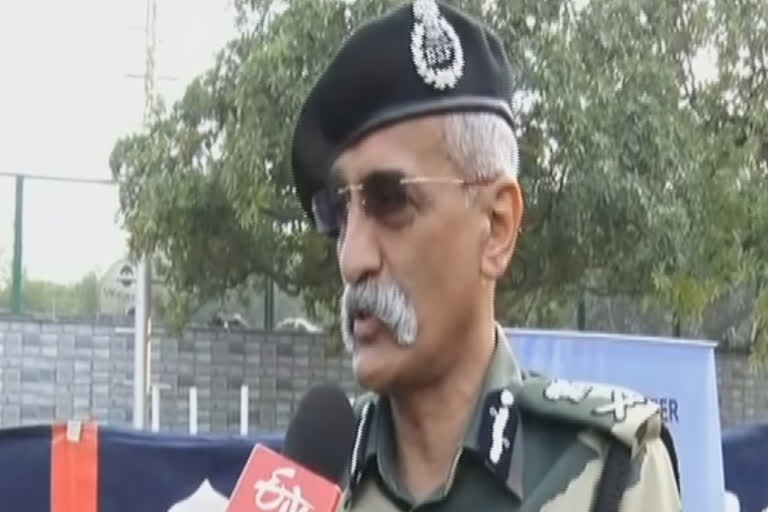New Delhi: As foreign terrorist organizations have been using drones to pump drugs, arms and ammunitions into India, the Border Security Force (BSF) has tied up with private universities to ascertain the origin and routes of such drones using latest technology.
“We are trying to analyze the chips used in the drones coming from across the border. We are analyzing their flight path and their origin,” said BSF Director General (DG) Pankaj Kumar Singh in an exclusive interview to ETV Bharat .
He said that such analysis has already led to the arrest of at least eight people involved in illegal business. “With the help of Punjab police, we have already arrested eight people. Among the total arrested, six people have been booked under the NDPS Act,” said Singh.
The DG also said that the agency has started providing incentives to the personnel for shooting down drones. “Last year only one drone was shot down whereas this year we have already shot down 16 drones,” said Singh.
“As on date close to 100 drones are available with field formations for area domination. MHA has authorized a significant number of drones which are in the process of procurement,” he said.
Till October this year, BSF has seized 518.27 kg narcotics, Rs 500 FICN (Fake Indian Currency Notes), 54 arms and 845 ammunitions. As many as 182 persons have been apprehended along the India-Pakistan border.
Referring to the influx of terrorists, Singh said that BSF has intensified its patrolling and already identified several vulnerable patches from where infiltrations take place.
The BSF is using Low Cost Surveillance System (LCTS) - Using PTZ Cameras, CCTV (Static) Cameras & IRIDS. “It aims to cover vulnerable patches under electronic surveillance. This ‘Improved Version ' of electronic surveillance project covers 635 vulnerable patches and 484 km over seven Frontiers (Jammu, Punjab, Rajasthan, Gujarat, South Bengal, North Bengal and Guwahati),” said Singh on the sidelines of an annual briefing of BSF.
He said that the Home Ministry already released Rs 40 crore for this low cost surveillance system and more than 5,000 cameras have already ben installed this year.
Elaborating on several initiatives by the BSF at the Indo-Pakistan border, the DG said that liaising for intelligence input and joint operations with sister agencies ; rigorous anti–tunneling exercise; deployment of CCTV and PTZ Cameras in sensitive areas of Punjab Frontier and of anti drone systems to tackle the menace of drones at the international border in Punjab and Jammu are being undertaken by the force.
Singh said with the Comprehensive Integrated Border Management System (CIBMS), the government integrates manpower, different sensors, networks, in C-2 Centre and control resources, so as to facilitate decision making and prompt process at various levels.
BSF has prepared a roadmap for installing technical solutions along the 2,290 kilometre international border. “In principle, a proposal for work under this project has been approved by the Ministry of Home Affairs,” he said.
The first phase will cover 310 Km of Jammu and part of Punjab Frontier, second phase will cover totaling 575 Km, third phase will cover the remaining part of Rajasthan and Gujarat and fourth phase will cover 964 km, including North Bengal and Guwahati Frontier. He said that two vehicle mounted jammers on Mahindra Scorpio vehicle have been procured for protection of troops during convoy duty between Jammu – Srinagar.
Indo-Bangladesh border:
The BSF DG said that illegal infiltration from Bangladesh is still an issue. “However, 10,000 people come to India from Bangladesh on a daily basis through a formal route,” said Singh. Referring to the use of lethal weapons along the border areas, the DG stated that use of such weapons have drastically gone down.
He, however, said that on many occasions criminals try to take advantage of the process. “Criminals are also aware about the use of non-lethal weapons by the BSF and taking advantage of it they want to overpower and snatch our weapons,” he said.
Singh said that 25,951.671 kg narcotics have been seized from eastern frontier till October this year, besides Rs 20,32,700 FICN, 18 arms of various types, 1,596 ammunition besides apprehension of 3,992 people.
“Smuggling of drugs and narcotics is a major concern and most of the consignment of this comes from Myanmar to the Northeast and rest of the country,” said Singh.



